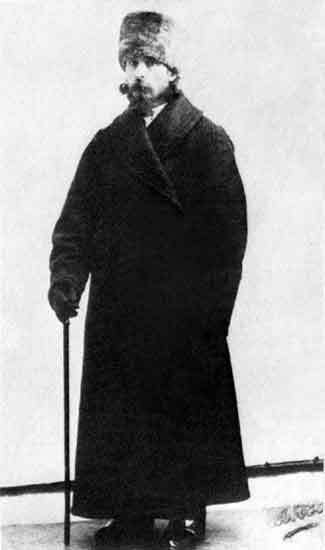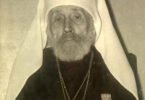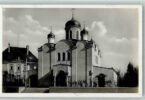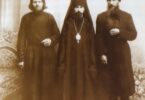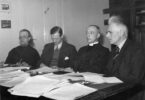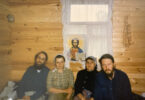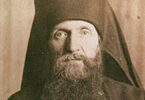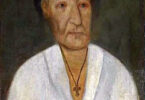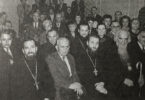Bishop Daniel Sherstennikov, Vicar Bishop of Kamchatka Diocese, passed away on February 1, 1932.
It seems that through the “wagon-circling” jurisdictional polemics of the previous decades, we ceased to focus on important nuances pertaining to the history of the Russian Church Abroad in general and its early history in particular. The Russian refugees did not believe that having crossed the border of Russia, they gave up the right to meddle in things there. Whenever they could – at the early stage, during World War II, and at Perestroika – they sought to be involved in the life of their homeland.
When, in December 1920, some of the members of the Supreme Church Authority in the South of Russia decided to continue their ministry abroad, not all the territory of the Russian Empire was yet under the Bolsheviks. The Far East of Russia remained free from Bolshevik rule until the end of 1922.
General Michael Diterikhs (d. 1937), one of the White Army leaders, who already in 1919 had started to organize military units of the Cross and the Crescent, believed that Bolshevism could only be defeated in a religious war. On November 22, 1921, a year after Wrangel’s defeat in Crimea, the White Army took Khabarovsk, the largest city of the Russian Far East, from the Bolsheviks. The émigrés hoped that the liberation of Russia could still begin from the Far East.
From July 23 until August 10, 1922, the Zemskii Sobor (Assembly of the Land) met in Vladivostok, consisting of over 200 members, including bishops and other clergy. Following that meeting, by the August 15 decision of General Michael Diterikhs, the parish was recognized as the basic administrative unit, and atheists were to be subjected to deportation from the territory controlled by the Zemskii Sobor. In the spirit of the 1919 Stavropol Council and of Metropolitan Antonii, the Zemskii Sobor classified Bolsheviks as non-Russian oppressors. Its resolution resonated with the 1921 Monarchical Congress in Bad Reichenhall and the 1921 Pan-Diaspora Council in Sremski Karlovci: “1. The Zemskii Sobor of Outer Manchuria (Priamur’e) recognizes that the rights to implement the Supreme authority in Russia belong to the dynasty of the House of Romanovs.”
207 delegates voted in favor of this resolution and 23 against it. The Far East episcopal conference that took place in September 1922 in the city of Nikoʹlsk Usuriiskii to prepare for a Church Council provides another illustration of temporary Church autonomy, based on the principle for how the Church was to organize itself in such circumstances (Decree 362). Russian hierarchs from China, Japan, and Serbia were able to communicate at this event organized in Russia, while it was almost impossible for them to have normal communication with the ecclesiastical authorities in Moscow. Svetlana Bakonina, a Moscow-based researcher of the Russian Church Abroad in Manchuria (St. Tikhon’s University of the Humanities), explained the events of the consecration of Bishop Daniel:
“[A]n emergency decision was made at the Bishops’ Conference to change the status of the Diocese of Kamchatka, which was in Russian territory; this was given emergency approval by the Synod of Bishops Abroad. On September 15 [1922], the day after the Bishops’ Conference adjourned, Bishop Mikhail of Vladivostok and Bishop Nestor of Kamchatka had already received telegrams from Karlovci splitting off the Diocese of Kamchatka (a semi-independent vicariate of the Diocese of Vladivostok) into an independent diocese and creating a Vicariate of Okhotsk within it. The Synod gave its blessing to Archpriest Daniil Sherstennikov, the former rector of the Kamchatka cathedral, who was in Vladivostok at that time, to fill the See of Okhotsk. In view of the order of the Synod Abroad, Bishop Nestor urgently left for Vladivostok to take part in the monastic tonsure and consecration of Father Daniel. It was assumed that the newly consecrated bishop would take the first ferry to Petropavlovsk, where he would stand in for Bishop Nestor. The latter was to depart for Europe to fulfill the mission entrusted to him by the Zemsky Sobor.
“After Father Daniel’s consecration, which took place in October, Bishop Nestor left for Japan, from whence he returned to Harbin on October 21, 1922, intending to stay there until November 1 and then travel to Western Europe by ship via Japan. But this trip never happened. After Red troops seized Primorʹe, the delegation from the Zemsky Sobor no longer had any reason to visit Europe.”
Bishop Daniel arrived in Petropavlovsk on October 25, 1922, when Vladivostok was taken over by Red Partisans. He continued ministering to his flock in Russia, was arrested, went to Solovki, was exiled, and died in 1932 in the Archangelsk region.
This activity of the Supreme Authority Abroad (division of Kamchatka diocese, approval of an episcopal candidate) is part of the early history of the ROCOR’s involvement in Russia. Similarly, during the arrest of Metropolitan Benjamin of Petrograd in 1922, chrism was delivered to some of the parishes of his diocese from Archbishop Seraphim of Finland, who at that time was under the Russian Church Abroad.
As with Crimea, the Russian Far East was not destined to become the “Russian Taiwan.” By October 25, 1922, the Far East was fully controlled again by the Bolsheviks. All of the bishops who had assembled in Nikolʹsk Usuriiskii emigrated and, with the exception of Bishop Nestor, died abroad.
Sources:
Svetlana Bekanina, “The Far Eastern Church District as an Alternative to the Supreme Church Administration Abroad (On the Closing Down of This Administration in 1922),” Historical Studies of the Russian Church Abroad.
O.V. Koisk, D.V. Savin, Daniil, Pravoslavania Entsiklopeida.

